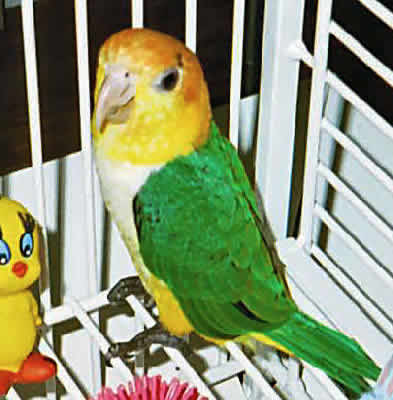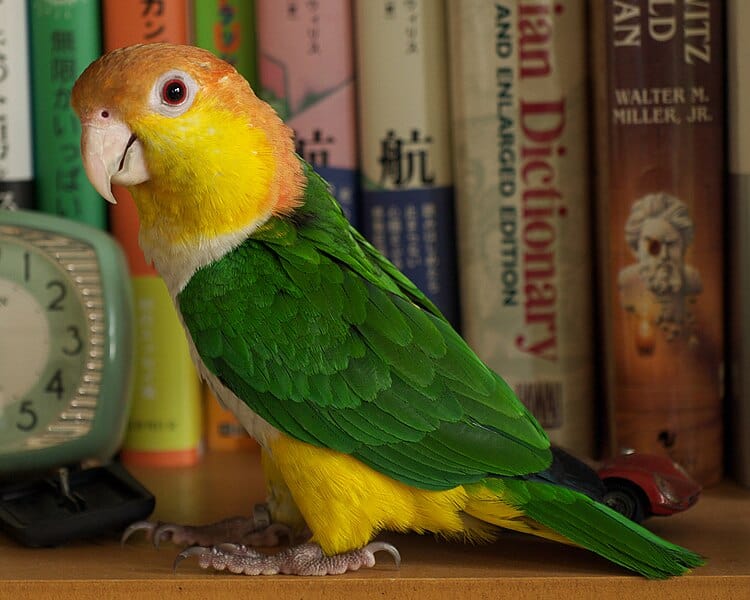
The Yellow-thighed Caiques loves to show off. Being very intelligent they quickly learn tricks..and then watch out!
The White-bellied Caiques, including this subspecies the Yellow-thighed Caique, are not only some of the most colorful birds in the parrot family, but are very inquisitive and outgoing. They have a very active nature and are guaranteed to get into anything they can.
A distinguishing characteristic of the Caique is a lovely ruffled looking white breast and belly. This gave rise to it’s name. ‘Caique’ is a term used to describe a full-dress, white shirt, with a ruffled front.
To learn more about Caique parrots visit:
Guide to a Happy, Healthy Caique
- Kingdom: Animalia
- Phylum: Chordata
- Class: Aves
- Order: Psittaciformes
- Family: Psittacidae
- Genus: Pionites
- Species: leucogaster xanthomeria
Scientific Name:
Sub-species:
- Yellow-thighed Caique
Pionites l. xanthomeria - White-bellied (White-breasted) Caique
Pionites l. leucogaster - Yellowed-tailed Caique
Pionites l. xanthurus
Distribution:
The Yellow-thighed Caique is found in South America along the upper Amazon river, specifically in Brazil, eastern Ecuador, and northernmost part of Bolivia. They inhabit the forest canopies in tropical zones.
Description:
All three subspecies of White-bellied Caique have a mostly orange colored head with the lores, sides of the head, and the throat being yellow. The back and wings are green and the breast and belly are primarily creamy-white. The beak is horn colored and the eye is reddish-brown. The Yellow-thighed Caique, true to its name, is distinguished from the others by having yellow thighs.
On juveniles the head is more brownish scattered with black feathers, the beak has gray markings by the base, and the eye is brown.
Size – Weight:
Though the Yellow-bellied Caique reach about 9″ (23cm) long from the head to the tip of the tail, the Yellow-thighed is just a little bit larger.
Care and feeding:
A roomy cage is required unless the bird is to be let out for extended periods. Many birds can spend most of their time on a play pen or parrot perch.
In the wild these birds eat fruits, seeds, and berries from the tree tops. The Caique’s main diet should primarily be seeds, fruits, and green vegetables. A commercially prepared parrot mix or pelleted diet can also be beneficial.
See About Caique Parrots: Housing and About Caique Parrots: Care and Feeding for more information.
Social Behaviors:
Caiques enjoy human interaction as well as interaction with other birds. In the wild the Yellow-thighed Caiques are very social birds usually seen in pairs, a family group, or a small flock. They are highly social birds with a very active nature. They will require a lot of interaction with either you or from another companion.
But despite this overall affectionate nature, some can get rather grumpy and nippy and can be aggressive to other birds. They should never be left unsupervised with other pets.
See About Caique Parrots: Handling/Training for information on developing a well rounded Caique
Activities:
They are very intelligent, energetic, and constantly on the move. Love to climb, play, and chew. They will get into anything and everything made available to them. Provide lots of toys and branches, and rotate new bird toys on a regular basis.
Breeding/Reproduction:
White-bellied Caiques are a challenge to breed, however they are being bred successfully. The female will lay two to four eggs which incubate for about 27 days. The male will feed the female while she is brooding, and will join her in the nest box at various times during the day and at night. The hatchlings will leave the nest at about 10 weeks.
Potential Problems:
Like most parrots, the caiques are quite hardy when provided a good environment and proper care.
See About Caiques: Potential Problems for more information.
Availability:
Caiques in general are not as available as other parrot species and are quite a bit more expensive. The Yellow-thighed Caique itself is not seen as often as the more common White-bellied Caique, but with increased breeding it is occasionally available.
Pionites leucogaster – pet perching near books (Image Credit: pionetes, Wikimedia Commons CC BY-SA 3.0 Unported)
